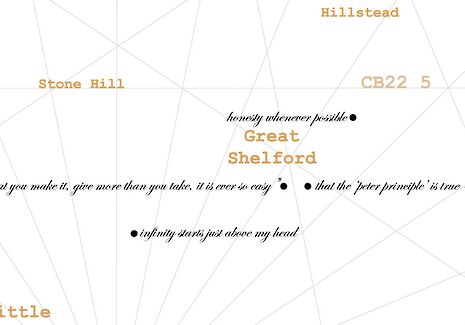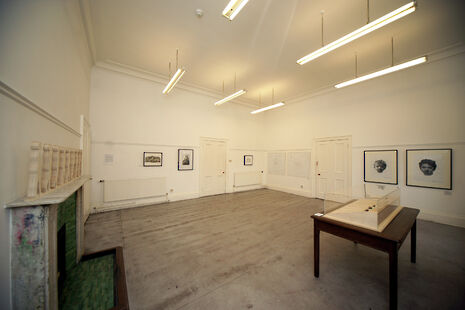The Hyphen Between Two Names
Aliya Ram talks to Agnes Poitevin-Navarre about cultural identity and being a late bloomer

Despite France’s seeming political progression to an anti-colonial nationalism that is blind to ugly questions about race and ethnicity, there survives beneath the surface an unsolved tangle of ethno-racial confusion. For Agnes Poitevin-Navarre, this confusion has been an inspiration – the stimulating source of her culturally concerned photograms, maps and multimedia installations.
Her most recent geographical wanderings brought her fast and focusedly from the National Geographic Society in London to the Kings’ art Room in Cambridge. And she made no casual matter of her new destination. The centre-piece of the Kings’ exhibit was a ‘Proustian Map of Cambridge’, created for and in collaboration with Cambridge residents who answered questions like, “What lesson has life taught you” and “What is your greatest achievement” in a survey for Poitevin-Navarre. The artist then compiled the answers into a large, somewhat astrological diagram with spidery lines that criss-crossed behind statements from Stone Hill and Great Shelford. The anonymity of the participants was highlighted by the piece, which allowed a viewer to dip into only such a tiny (albeit intimate) part of each Cantabrigian mind.
Poitevin-Navarre’s interest in mixing people who are bound together by a coincidence of location extends in some of her other work to include people bound together by a coincidence of vocation. Indeed the piece which gave the exhibit its name, Fellow Artists, Fellow Muses, places Poitevin-Navarre next to some of her favourite female contemporary artists whose locks of hair replace brush bristles in the paint brushes that divide the artists from each other.
It seems appropriate now, a few months after her exhibit at the Kings’ art room, to ask the artist about her work and where it might take her next.
ALIYA RAM: Since cultural identity plays such a large part in your work, it feels right to start by asking you how you identify yourself culturally.
AGNES POITEVIN-NAVARRE: As you can deduce from my name, I am French, but have lived in England for 22 years. I am the hyphen between the two names. ‘Poitevin’ means people who live in the Poitou region, and ‘Navarre’ was a kingdom between France and Spain. My late father was black and came from Guyane Française, a French colony in South America, famous for the Ariane rockets programme, the European version of NASA. He migrated to France in the early sixties. My mother is French French (she is white). When people ask where I am from, they are never satisfied when I say I am French. The ‘from’ question is always loaded, it is not about nationality, it is about ethnicity or about class.
What part has this cultural background played in your work?
In France, we have an expression “Français de souche”, which means an indigenous white Frenchman. The expression is used to differentiate the gaulois [think Asterix & Obelix!] from successive waves of immigrants. The phrase has a political subtext that betrays a lot of colonial baggage.
So how did you get to where you are now in England?
I am a late bloomer. Indeed I get comfort knowing that Louise Bourgeois was a “peripheral figure in art whose work was more admired than acclaimed”, and found success very late in her art career. She was experimental and had integrity. Getting a First Class (Hons.) Degree in Fine Art at Canterbury, equipped with my French-English dictionary, and then going to the Slade for my MA has undeniably opened doors. If you are good, aim for the best school! By the end of my MA, my work was mildly admired but not acclaimed and the myths about curators and collectors picking artists didn’t apply to me. They have agendas for which sometimes you fit and sometimes you don’t. So nurture your belief and carry on making good work.
How has your work changed with time?
My earlier work was totally autobiographical and then with time it became a platform through which to engage with my fellows humans. Hence the maps and the ‘Fellow Artists, Fellow Muses’ piece. My work used to be really opaque. It took having my kids to kick-start my making art again, this time with clarity and enjoyment.
When you say ‘a platform through which to engage with your fellow humans’, what exactly do you mean, what did you do to engage?
Well, the Proustian map is about encapsulating the ephemeral feel of a town by sharing anecdotal evidence of the greatness of anonymous individuals. The Fellow Artists Fellow Muses piece came for a realisation about how important validation of my art practice is to me. I approached fellow artist friends and galleries representing women artists I admire - they had to be living artists as I required a lock of their hair. Louise Bourgeois was still alive then. Cornelia Parker’s assistant informed me that she was away but wished me luck. Sophie Calle and Bridget Riley’s contact went nowhere. Antoni’s gallerist said that Antoni thought of her hair as sacred and would not grant my request.
Was that one of your most important pieces?
Each piece of artwork shown in Cambridge is important because they trace my artistic journey until now. The "Fellow Artists - Fellow Muses" is a key piece because it deals with feminist issues. It subverts the idea of a male (active) artist and a female (passive) muse as seen in art, fashion, music, etc. It is a take on what it means to be a contemporary female artist, playing on the assumption that a woman artist is a painter.
The last piece I created was Le Fil d'Ariane/The Ariadne Thread, that I describe as “the embroidered diagram locating my fleeting presence during my art residency at King’s College Cambridge, by using my own hair to record the floorplans of the prestigious location”. I threaded my hair on metis linen [50% cotton, 50% linen] - the audience can then interpret the code. Someone said it “reminded them that we become woven into the fabric of Cambridge, just as much as Cambridge will always be a part of us.”
Where do you think you’re going next with your work?
America is calling me! Still, my next commission is another version of the Proustian map for the London Transport Museum, to be shown in May 2012. I am also exploring the idea of representing a codified body language in a photographic and wood-cut series, although it’s early days yet. But that’s the future… the Cambridge show has been great on many levels. I should thank the curator Natalie McIntyre for the opportunity to exhibit there, and also all the Proustians for making the exhibit very special indeed.

'Fellow Artists Fellow Muses' ran at King's College Cambridge Art Centre
from Friday 11th November until Saturday 26th November
 Lifestyle / The woes of intercollegiate friendships8 May 2025
Lifestyle / The woes of intercollegiate friendships8 May 2025 Lifestyle / A beginners’ guide to C-Sunday1 May 2025
Lifestyle / A beginners’ guide to C-Sunday1 May 2025 News / Angela Rayner could intervene to stop Trinity ‘mothballing’ planned affordable homes site7 May 2025
News / Angela Rayner could intervene to stop Trinity ‘mothballing’ planned affordable homes site7 May 2025 News / Graduating Cambridge student interrupts ceremony with pro-Palestine speech3 May 2025
News / Graduating Cambridge student interrupts ceremony with pro-Palestine speech3 May 2025 Features / The quiet saboteur: when misogyny comes from within7 May 2025
Features / The quiet saboteur: when misogyny comes from within7 May 2025






